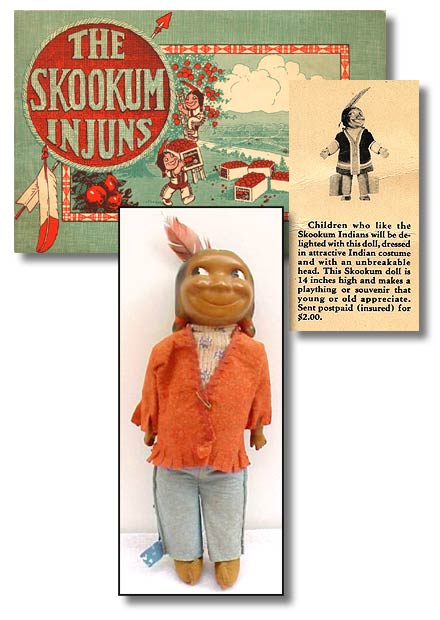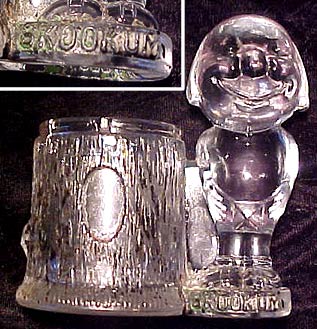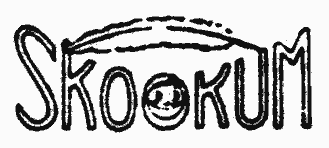|
 or most collectors one of the challenges and pleasures of collecting is researching the objects of their desire. For Skookum doll collectors of the past, this was no easy task as little to no information was published about them. While doing Skookum doll research, several names always seem to be mentioned and affiliated with the origins of the dolls. Although not related to the “true” Skookum Bully Good doll except by the use of the word “Skookum,” the apple growers of the Skookum Packers Association, Louis Amberg and Sons, and the George Borgfeldt Co. are frequently, and at times erroneously, cited. The names were often interchanged and assumptions were made based on previous findings, resulting in misinformation and confusion. Some of this misinformation found its way into print, further confounding Skookum collectors. or most collectors one of the challenges and pleasures of collecting is researching the objects of their desire. For Skookum doll collectors of the past, this was no easy task as little to no information was published about them. While doing Skookum doll research, several names always seem to be mentioned and affiliated with the origins of the dolls. Although not related to the “true” Skookum Bully Good doll except by the use of the word “Skookum,” the apple growers of the Skookum Packers Association, Louis Amberg and Sons, and the George Borgfeldt Co. are frequently, and at times erroneously, cited. The names were often interchanged and assumptions were made based on previous findings, resulting in misinformation and confusion. Some of this misinformation found its way into print, further confounding Skookum collectors.
As discussed in our other feature article in this issue of SkookumNews, “Skookum! What the Dickens is Skookum?”, the word “Skookum” attained great popularity in the late teens and early 20s. Mary McAboy, the creator of Skookum Bully Good Indian dolls, wasn’t the only one who thought the name was catchy!
The Skookum apple packers of Wanatchee Washington went to great lengths to advertise their Skookum Apples with ads in national magazines and newspapers. Several Apple cookbooks were offered to homemakers as well. It was within the pages of these cookbooks that one could find an offer for “Skookum, The Bully Kiddo Doll.” The doll, available in several sizes over the years, is a cartoonish looking fellow fashioned after their trademark Indian. The doll has composition head and hands and wears colorful felt clothing over a soft stuffed body. In 1916 Louis Amberg and Sons won the rights to produce the doll.
 |
|
The Skookum Packer’s Association coloring book, promotional ad for their “Bully Kiddo” doll, and the doll itself, manufactured by Louis Amberg & Sons.
|
It is sometimes stated that Mary McAboy’s Skookum dolls were made or distributed by Amberg, and or that her dolls were available, or given as a premium, by the Skookum apple growers of Washington State. That however is not the case. Although sharing the Skookum name, the dolls and their makers were totally unique to each other.
Also mentioned in reference to the history of Skookum Indian dolls is George Borgeldt & Co., of New York, NY. The company, founded by George Borgfeldt and Marcell and Joseph Kahle, was a large importer and wholesaler of toys and dolls. The Borgfeldt Co jumped onto the “Skookum” bandwagon and in May of 1916 patented a Skookum logo trademark. It is not unusual to read mention of Borgfeldt in association with Skookum dolls although he never produced dolls using the trademark or name. Borgfeldt did however offer a glass “Skookum” candy container.
 |
|
George Borgfeldt & Co.’s “Skookum” candy container. Photo courtesy Bill Corbett
|
A popular novelty, the clear glass painted container was in the shape of an Indian standing beside a tree stump. Similar containers were available from Sears and Roebuck in the teens and 20s. Interestingly, the smiling Indian of the Borgeldt trademark closely resembles the Indian used in the ads of the Apple Packers Association.
 |
|
Borgfeldt’s patented logo
|
Mary McAboy’s Skookum Bully Good Indian dolls enjoyed a long production run through the H.H.Tammen Company of Denver Colorado and were distributed by them using the Tammen label in Denver, Los Angeles and New York. Skookum dolls were also distributed in the East by the Arrow Novelty Co. Skookum dolls can be found with their ANCO label.
Although Amberg, Borgfeldt, and the Bully Kiddo may have liked the word Skookum, there is only one Bully Good!
|
|